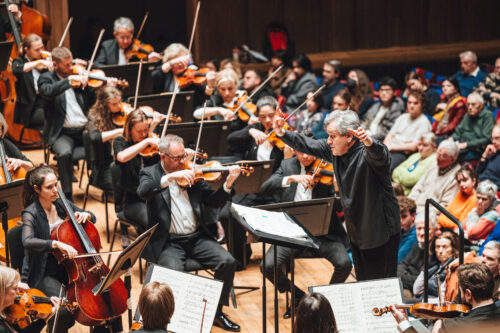 United Kingdom Walton, Mahler: Rebecca Gilliver (cello), London Symphony Orchestra / Sir Antonio Pappano (conductor). Bristol Beacon, 13.2.2025. (CK)
United Kingdom Walton, Mahler: Rebecca Gilliver (cello), London Symphony Orchestra / Sir Antonio Pappano (conductor). Bristol Beacon, 13.2.2025. (CK)

Walton – Cello Concerto
Mahler – Symphony No.1
It was a pleasure to return to Bristol Beacon after my first visit last November, and to admire its rebirth as a magnificent and welcoming hall, with light and spacious public spaces and a real sense of occasion. A full-strength London Symphony Orchestra was on display for this concert under their Chief Conductor Sir Antonio Pappano, and there was an enthusiastic full house to greet them. The work after the interval was to be Mahler’s First Symphony: but first we were treated to music of a very different cast, Walton’s late-flowering Cello Concerto.
The Elgar Cello Concerto is often described as autumnal – Walton’s is too, but in a more relaxed and Mediterranean way. A soft dissonance on harp, vibraphone and other instruments opens the door into a soundworld that suggests Sir William relaxing in his garden on the island of Ischia. No hummable tunes such as Elgar gives us, but a sensuous, effortless lyrical flow, the solo cello line borne along on gently glinting orchestral colours – bass clarinet, celeste and harp, softly chiming flutes and oboes, a beautiful wash of sound from the violins (divided left and right); and a wonderful arrival at a major-key cadence before the music fades to nothing in a shimmering haze.
It was a pleasure to hear the concerto played by Rebecca Gilliver, stepping out of her regular role as leader of the LSO’s cello section; she seemed ideally suited to the work, sustaining the music’s wide-ranging lyrical flow in a continuous line, never breaking it up in an attempt to impose interpretative points or to assert her own musical personality. If that sounds a polite way of describing her playing as characterless, the scherzo (Allegro appassionato) and finale provided emphatic evidence to the contrary: but I would always want to hear the first movement – my favourite – as it was played here.
The scherzo reminds us of the Walton of the First Symphony, but without malice: soloist and orchestra (including the percussion) have to be light on their feet. My companion detected music very akin to Walton’s score for the film Battle of Britain. The extended finale – four ‘improvisations’ on a theme of Walton’s own – begins ruminatively on the solo cello against pizzicato strings; it ranges widely in mood and colour – by turns playful, fantastic, dreamy. There is much to catch the ear: dabs of tuned percussion, an aspiring oboe solo, harmonics on the cello. The soloist has two of the improvisations to herself, cadenza-like in virtuosity; Gilliver dug in, where necessary, with energy and force. They were separated by a purely orchestra improvisation – the only place in the whole work where the full orchestra plays. The ending was magical: the music takes on a sunset glow as it slowly sinks beneath the horizon – harp, strings, celeste, those gently chiming woodwinds – the solo cello singing to the end. Though the piece is not an obvious crowd-pleaser, the playing of soloist and orchestra, together with Pappano’s alertly sensitive conducting, cast a genuine spell, which was reflected in the warmth of its reception.

After the interval, the stage filled up with the forces necessary for Mahler 1 – quadruple woodwind, eight horns, five trumpets, two sets of timpani and the rest. What an amazing beginning it is to Mahler’s (or anyone’s) symphonic career; never more so than in the first sound we hear; that supernatural A stretched across seven octaves on the strings. And as the LSO laid out the fine detail of this super-sensitised opening soundscape – that deliciously sleepy pair of horns basking in the sun – it was abundantly clear what a thoroughbred orchestra they are: their unanimity, their hair-trigger precision in responding to Pappano’s smallest gestures, the sheen on their sound all went to make their excellence beyond doubt before any of them had reached forte. The central episode of sultry midday heat – with those soft, slightly sinister strokes on the bass drum – was spellbinding; and the Durchbruch – Adorno’s term for the moment when the music breaks through to widescreen glory – was exhilarating, the horns whooping and trilling for all they were worth. The final argument between timpani and orchestra about who gets to have the last word brought delighted smiles.
The Scherzo set off at a comfortable gait; the rasping horns, bells up, again caught both eye and ear. The Trio section brought delectable playing from strings, woodwind and horns, and a bright pair of trumpets. The third movement’s spooky canon was set in motion by a wonderfully outlandish double bass solo, with a weird tuba and a shrill quartet of flutes soon joining in. Pappano revelled in drawing out the music’s hesitations and hold-ups without ever overcooking the movement’s knowing irony. The sweetly hushed intrusion of the Lindenbaum music that closes the Lieder eines Fahrenden Gesellen was played with throat-catching beauty. Pappano then paced the finale to perfection, as much in the contrasting episodes as in the stormy and eventually triumphant passages where he gave the brass their head. And so, we arrived at the work’s unequivocal triumph, the horns standing in a shining row (about 20 bars after Mahler asks them to – but arguably with greater dramatic effect, blasting out the theme fff).
At the end my companion and I burst out laughing. That is how the music makes you feel. It is 58 years since I first encountered the music of Mahler – this symphony, in this hall’s previous incarnation. I was 18; and a really good performance can still make me feel 18 again. This performance emphatically did the trick; and, as I am writing this, it is still working.
Chris Kettle
